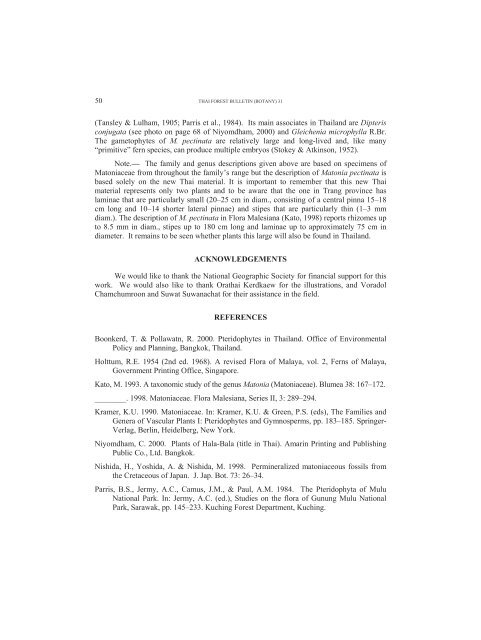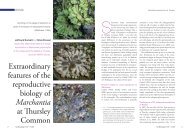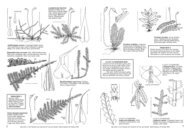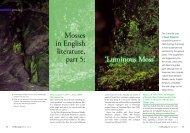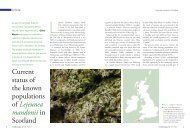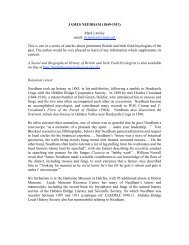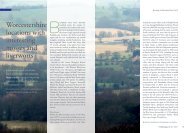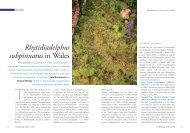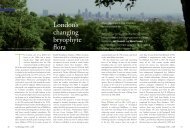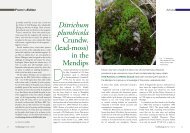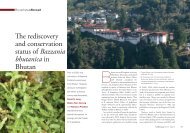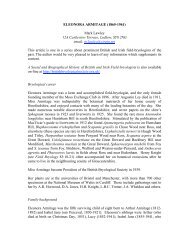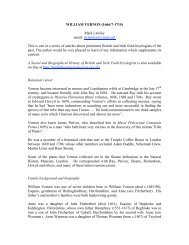Matoniaceae (Pteridophyta) - a new family record for Thailand ...
Matoniaceae (Pteridophyta) - a new family record for Thailand ...
Matoniaceae (Pteridophyta) - a new family record for Thailand ...
Create successful ePaper yourself
Turn your PDF publications into a flip-book with our unique Google optimized e-Paper software.
50<br />
THAI FOREST BULLETIN (BOTANY) 31<br />
(Tansley & Lulham, 1905; Parris et al., 1984). Its main associates in <strong>Thailand</strong> are Dipteris<br />
conjugata (see photo on page 68 of Niyomdham, 2000) and Gleichenia microphylla R.Br.<br />
The gametophytes of M. pectinata are relatively large and long-lived and, like many<br />
“primitive” fern species, can produce multiple embryos (Stokey & Atkinson, 1952).<br />
Note.— The <strong>family</strong> and genus descriptions given above are based on specimens of<br />
<strong>Matoniaceae</strong> from throughout the <strong>family</strong>’s range but the description of Matonia pectinata is<br />
based solely on the <strong>new</strong> Thai material. It is important to remember that this <strong>new</strong> Thai<br />
material represents only two plants and to be aware that the one in Trang province has<br />
laminae that are particularly small (20–25 cm in diam., consisting of a central pinna 15–18<br />
cm long and 10–14 shorter lateral pinnae) and stipes that are particularly thin (1–3 mm<br />
diam.). The description of M. pectinata in Flora Malesiana (Kato, 1998) reports rhizomes up<br />
to 8.5 mm in diam., stipes up to 180 cm long and laminae up to approximately 75 cm in<br />
diameter. It remains to be seen whether plants this large will also be found in <strong>Thailand</strong>.<br />
ACKNOWLEDGEMENTS<br />
We would like to thank the National Geographic Society <strong>for</strong> financial support <strong>for</strong> this<br />
work. We would also like to thank Orathai Kerdkaew <strong>for</strong> the illustrations, and Voradol<br />
Chamchumroon and Suwat Suwanachat <strong>for</strong> their assistance in the field.<br />
REFERENCES<br />
Boonkerd, T. & Pollawatn, R. 2000. Pteridophytes in <strong>Thailand</strong>. Office of Environmental<br />
Policy and Planning, Bangkok, <strong>Thailand</strong>.<br />
Holttum, R.E. 1954 (2nd ed. 1968). A revised Flora of Malaya, vol. 2, Ferns of Malaya,<br />
Government Printing Office, Singapore.<br />
Kato, M. 1993. A taxonomic study of the genus Matonia (<strong>Matoniaceae</strong>). Blumea 38: 167–172.<br />
________. 1998. <strong>Matoniaceae</strong>. Flora Malesiana, Series II, 3: 289–294.<br />
Kramer, K.U. 1990. <strong>Matoniaceae</strong>. In: Kramer, K.U. & Green, P.S. (eds), The Families and<br />
Genera of Vascular Plants I: Pteridophytes and Gymnosperms, pp. 183–185. Springer-<br />
Verlag, Berlin, Heidelberg, New York.<br />
Niyomdham, C. 2000. Plants of Hala-Bala (title in Thai). Amarin Printing and Publishing<br />
Public Co., Ltd. Bangkok.<br />
Nishida, H., Yoshida, A. & Nishida, M. 1998. Permineralized matoniaceous fossils from<br />
the Cretaceous of Japan. J. Jap. Bot. 73: 26–34.<br />
Parris, B.S., Jermy, A.C., Camus, J.M., & Paul, A.M. 1984. The <strong>Pteridophyta</strong> of Mulu<br />
National Park. In: Jermy, A.C. (ed.), Studies on the flora of Gunung Mulu National<br />
Park, Sarawak, pp. 145–233. Kuching Forest Department, Kuching.


